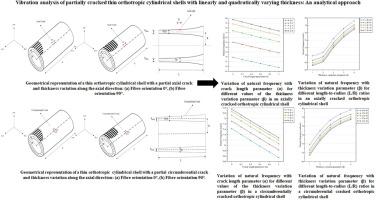线性和二次变厚正交各向异性薄圆柱壳部分开裂振动分析:一种解析方法
IF 6.6
1区 工程技术
Q1 ENGINEERING, CIVIL
引用次数: 0
摘要
本文建立了具有线性和二次变化厚度的正交各向异性薄圆柱壳的自由振动分析模型。假设壳的长度明显大于其其他尺寸,并考虑一个小的跨中表面裂纹来评估其对动力性能的影响。利用经典壳体理论推导了运动控制方程,并利用Donnell-Mushtari-Vlasov (DMV)公式进行了简化,以考虑厚度变化的影响。采用基于线弹簧模型(LSM)的裂纹柔度系数,考虑轴向和周向裂纹方向,对裂纹诱导的刚度降低进行建模。明确讨论了变厚度对结构刚度和振动特性的影响。利用Hamilton原理和分离变量法,得到了简支固支边界条件的封闭解。通过与已有文献的比较,验证了分析结果。对厚度梯度、裂纹尺寸和位置以及正交各向异性材料特性对基频的影响进行了综合参数化研究。本文章由计算机程序翻译,如有差异,请以英文原文为准。

Vibration analysis of partially cracked thin orthotropic cylindrical shells with linearly and quadratically varying thickness: An analytical approach
This study presents an analytical model for the free vibration analysis of thin orthotropic cylindrical shells featuring linearly and quadratically varying thickness. The shell is assumed to have a length significantly greater than its other dimensions, and a small mid-span surface crack is considered to evaluate its impact on dynamic behaviour. The governing equations of motion are derived using classical shell theory and simplified using the Donnell–Mushtari–Vlasov (DMV) formulation to incorporate the effects of thickness variation. Crack-induced stiffness reduction is modelled using crack compliance coefficients based on the Line Spring Model (LSM), accounting for both axial and circumferential crack orientations. The influence of variable thickness on structural stiffness and vibration characteristics is explicitly addressed. A closed-form solution for simply supported and clamped boundary conditions is obtained via Hamilton’s principle and separation of variables. The analytical results are validated through comparison with existing literature. A comprehensive parametric study is conducted to assess the effects of thickness gradients, crack size and position, and orthotropic material properties on the fundamental natural frequency.
求助全文
通过发布文献求助,成功后即可免费获取论文全文。
去求助
来源期刊

Thin-Walled Structures
工程技术-工程:土木
CiteScore
9.60
自引率
20.30%
发文量
801
审稿时长
66 days
期刊介绍:
Thin-walled structures comprises an important and growing proportion of engineering construction with areas of application becoming increasingly diverse, ranging from aircraft, bridges, ships and oil rigs to storage vessels, industrial buildings and warehouses.
Many factors, including cost and weight economy, new materials and processes and the growth of powerful methods of analysis have contributed to this growth, and led to the need for a journal which concentrates specifically on structures in which problems arise due to the thinness of the walls. This field includes cold– formed sections, plate and shell structures, reinforced plastics structures and aluminium structures, and is of importance in many branches of engineering.
The primary criterion for consideration of papers in Thin–Walled Structures is that they must be concerned with thin–walled structures or the basic problems inherent in thin–walled structures. Provided this criterion is satisfied no restriction is placed on the type of construction, material or field of application. Papers on theory, experiment, design, etc., are published and it is expected that many papers will contain aspects of all three.
 求助内容:
求助内容: 应助结果提醒方式:
应助结果提醒方式:


